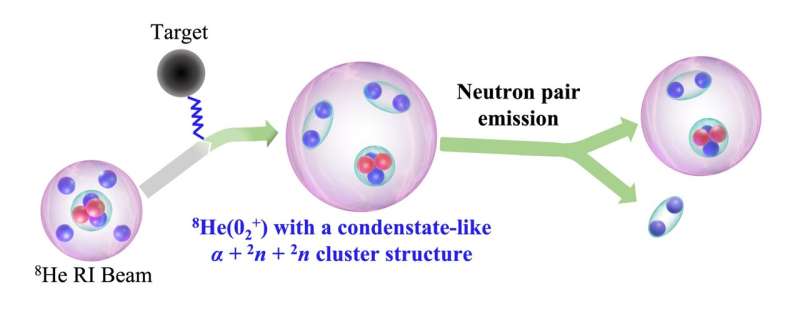
Schematic diagram of the population and decay of the 8He(02+) cluster state. Credit: Z. Yang/ Peking University
Researchers at Peking University in China have successfully observed the elusive 02+ state of 8He, revealing a novel cluster structure with two strongly correlated neutron pairs. This finding provides insights into exotic nuclear structures and their potential implications for understanding neutron stars. The findings are published in Physical Review Letters.
The conventional nuclear model in physics posits a single-particle picture where nucleons, protons, and neutrons move independently within a nucleus, forming a well-defined shell structure. Governed by a mean potential created by nuclear forces, nucleons fill distinct energy levels or shells, leading to increased stability associated with magic numbers.
This model, rooted in quantum mechanics, successfully explains nuclear structure and stability but encounters limitations when addressing exotic nuclei, particularly those that are neutron-rich and unstable.
First author of the study, Prof. Zaihong Yang, explained the team’s motivation to Phys.org, “As a nuclear physicist, one of our primary goals is to understand what is the structure of the nucleus and how it arises from the complex nuclear interactions between the constituent nucleons.”
Of particular interest is the condensate-like cluster structure in the neutron-rich nucleus 8He.
“A condensate-like cluster state made of one alpha plus two dineutron clusters has been theoretically predicted in the neutron-rich nucleus 8He, but its experimental observation has remained elusive due to the difficulty in both the production and identification of this exotic cluster state,” said Prof. Yang.
Cluster states & resonant states of 8He
The cluster state mentioned refers to a specific nuclear configuration in the neutron-rich nucleus 8He.
In this state, two strongly correlated neutron pairs, known as dineutron clusters, combine with an alpha cluster (four helium nuclei), forming what the researchers describe as a “condensate-like cluster structure.”
The term “condensate-like” draws an analogy to Bose-Einstein condensates (BECs), a state of matter formed at extremely low temperatures.
In BECs, particles such as atoms occupy the same quantum state, exhibiting collective behavior. Similarly, in the context of the 8He cluster state, the term suggests that the two dineutron clusters and the alpha cluster collectively contribute to the nuclear structure.
The dineutron clusters are denoted as 02+, with “0” indicating the spin-parity (in this case, spin 0), the “2” being the energy state, and the “+” is the parity (positive).
To observe the theorized state, the research team performed a nuclear scattering experiment at the RIKEN Nishina Center in Japan. This experimental endeavor was designed to probe and scrutinize the theorized cluster state within 8He.
The focus was on distinctive characteristics, including the elusive spin parity of the cluster state, an unusually considerable isoscalar monopole transition strength, and the emission of a strongly correlated neutron pair.
“Together with the state-of-the-art theoretical calculations, our results provide strong evidence that the four valence neutrons in the 02+ excited state of 8He can form two strongly correlated neutron pairs (dineutron clusters) and further form an exotic condensate-like cluster structure,” explained Prof. Yanlin Ye, second author of the study.
This accomplishment not only validates theoretical predictions but also underscores the ingenuity required in experimental design to navigate the intricacies of nuclear physics.
Speaking of which, Prof. Yang said, “One immediate implication of our finding is that unstable nuclei lying at the limit of stability can exhibit exotic structures that are distinct from the conventional single-particle or shell-model pictures, calling for improvement of nuclear structure theories.”
“Furthermore, while the nucleus is essentially made of fermionic nucleons (protons and neutrons), our results show that the structure of this 02+ state is nevertheless bosonic—a BEC-analogous cluster state—made of two dineutron clusters and one alpha cluster.”
Neutron stars & pulsars
The observed 02+ state of 8He has implications beyond nuclear and quantum physics. It carries profound significance for our understanding of astrophysical phenomena, specifically the cooling process of neutron stars and glitches in pulsars.
Dr. Yang elucidated the potential link between the 02+ state and neutron stars. The observed condensate-like cluster structure aligns with the suggested onset of neutron superfluidity in the interiors of neutron stars. This phenomenon is akin to the condensation of electron Cooper pairs in superconductors.
“While we can not visit a real neutron star to acquire its dense neutron-rich matter, its properties can be inferred from experiments with finite nuclei in the laboratory.”
“The 02+ state, characterized by its unique cluster configuration, offers valuable insights into the formation of a condensation state of neutron pairs. Importantly, it could be a precursor state for a macroscopic condensate of neutron pairs in neutron-rich systems, including neutron stars,” he explained.
This connection between nuclear physics and astrophysics not only enhances our understanding of exotic nuclear structures but also contributes to unraveling the mysteries of cosmic phenomena, shedding light on the intricate interplay between the microscopic world of nuclei and the macroscopic realms of neutron stars and pulsars.
In envisioning the path forward, the researchers anticipate extending measurements to other neutron-rich nuclei lying around the neutron drip line (the limit of existence on the nuclear chart).
“We’re particularly interested in how the condensate-like cluster structure evolves with more dineutron clusters. Exploring systems made purely of neutrons, like tetraneutrons and hexaneutrons, adds intrigue.”
“Production and identification of such states are challenging, but the construction of worldwide radioactive ion-beam facilities and new detector systems offers good opportunities,” concluded Prof. Ye.
More information:
Z. H. Yang et al, Observation of the Exotic 02+ Cluster State in 8He, Physical Review Letters (2023). DOI: 10.1103/PhysRevLett.131.242501
© 2023 Science X Network
Citation:
Beyond boundaries: Exploring exotic nuclear landscapes and their cosmic implications (2023, December 28)
retrieved 29 December 2023
from https://phys.org/news/2023-12-boundaries-exploring-exotic-nuclear-landscapes.html
This document is subject to copyright. Apart from any fair dealing for the purpose of private study or research, no
part may be reproduced without the written permission. The content is provided for information purposes only.
>>> Read full article>>>
Copyright for syndicated content belongs to the linked Source : Phys.org – https://phys.org/news/2023-12-boundaries-exploring-exotic-nuclear-landscapes.html
